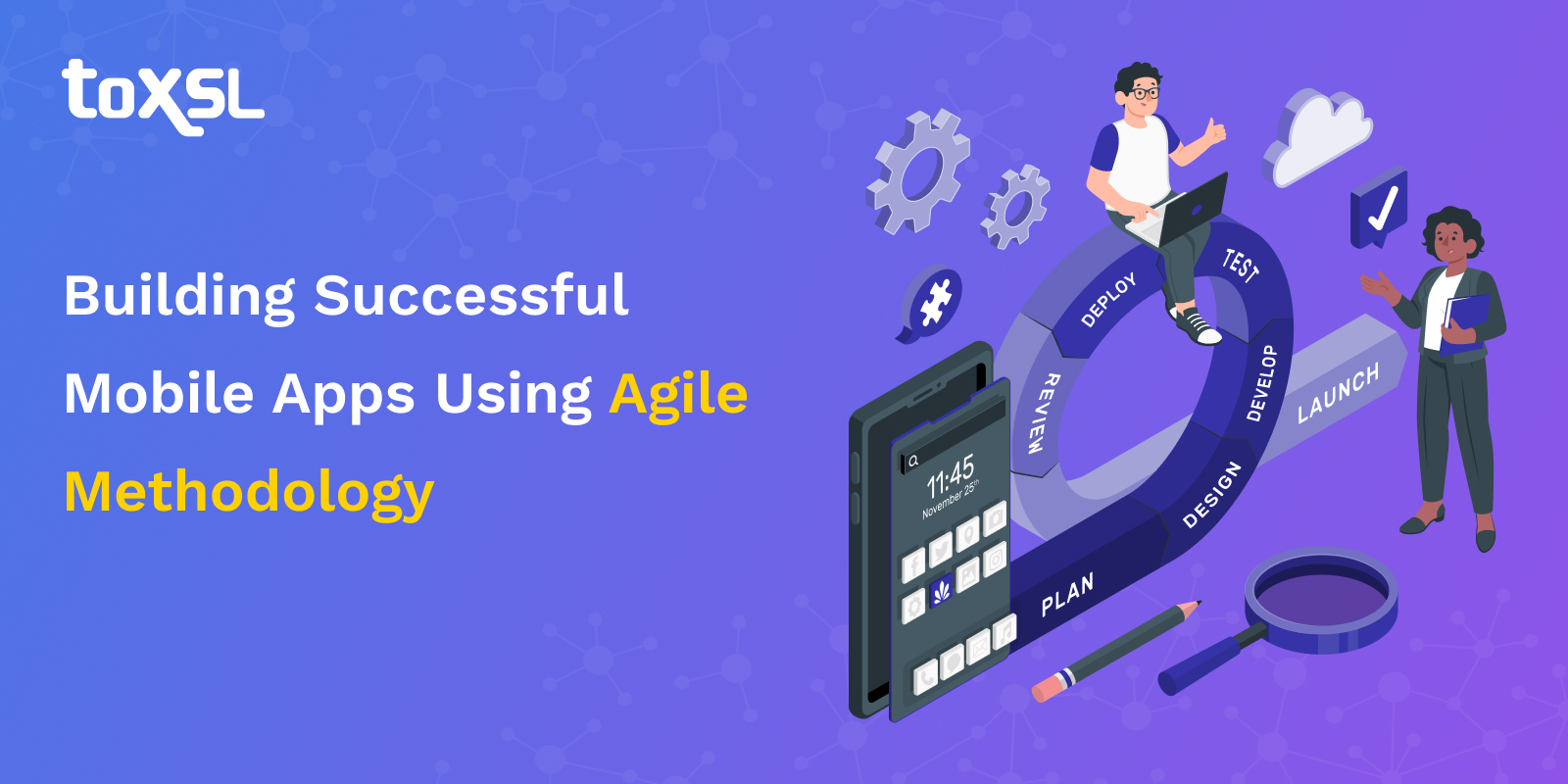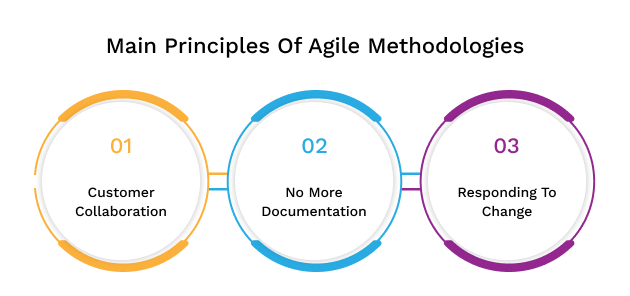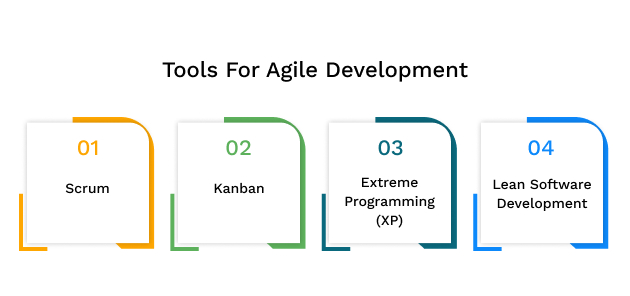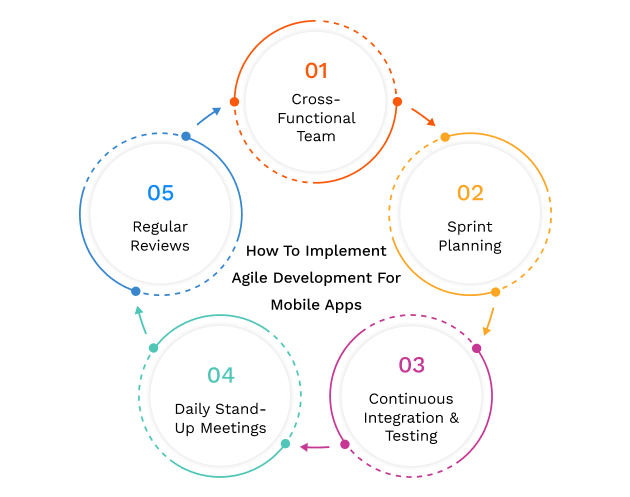- Dec 12, 2025
Share this post on:

Today, we live in a highly competitive world where building high-quality apps has become crucial for all software businesses. One of the most popular methodologies to ensure high-quality app development is the use of agile methodologies. These methodologies allow development teams to respond to changing market requirements, enhance collaboration, and increase sales rates. Before moving further in the article, let us understand the agile methodology.
Benefits of Agile Methodologies in Mobile Apps
Agile methodologies play a crucial role in the development of mobile apps. These methodologies provide a flexible and iterative approach to software development, allowing teams to adapt to changing requirements and deliver high-quality mobile apps efficiently. Let us explore the importance of Agile methodologies in mobile app development and how they contribute to successful app development projects.

Flexibility and Adaptability: Agile methodologies focus on flexibility and adaptability throughout the development process. Mobile app development often involves enhanced requirements due to changing user needs, market trends, or technological advancements. The agile method allows teams to respond quickly to these changes by continuously refining and reprioritizing the product backlog. This flexibility ensures that the final product meets the evolving needs of users and stakeholders.
Faster Time-to-Market: Agile methodologies promote shorter development cycles known as sprints. Each sprint lasts for a few weeks and focuses on delivering specific functionalities. By breaking down the development process into smaller iterations, Agile enables a faster time-to-market for mobile apps. It is particularly crucial in the fast-paced mobile app industry, where being first to market can provide a competitive advantage.
Improved Collaboration and Communication: Agile methodologies enhance collaboration and communication among team members, stakeholders, and clients. The cross-functional teams encourage close collaboration between developers, designers, testers, and other stakeholders throughout the entire development process. Regular meetings, such as daily stand-ups, sprint planning sessions, and effective communication, ensure everyone is aligned with project goals and progress.
Higher Quality Deliverables: Agile methodologies prioritize delivering working software at the end of each sprint. This iterative approach allows for continuous testing and feedback, enabling early detection of bugs or issues. By addressing these issues, teams can ensure higher-quality deliverables. Additionally, Agile promotes regular user feedback, allowing developers to incorporate user suggestions and preferences into the app's design and functionality.
Increased Customer Satisfaction: Agile methodologies focus on delivering value to customers through early and continuous delivery of working software. Agile ensures that their needs and expectations are met by involving customers throughout the development process. Regular demonstrations of working features or prototypes allow customers to provide feedback and make necessary adjustments, increasing customer satisfaction.
Risk Mitigation: Agile methodologies help mitigate risks associated with mobile app development projects. By breaking down the development process into smaller iterations, teams can identify and address potential risks early on. Regularly reviewing project progress allows teams to mitigate risks effectively. Additionally, Agile promotes transparency, enabling stakeholders to have a clear understanding of the project's status and potential challenges.
Main Principles of Agile Methodologies
Agile methodologies are guided by several main principles that contribute to their effectiveness in mobile app development:

Customer Collaboration: Agile methodologies prioritize collaboration with customers throughout the development process. This principle ensures that customer needs and expectations are constantly addressed, leading to a better end product.
No More Documentation: While documentation is crucial, Agile methodologies prioritize delivering working software over extensive documentation. This principle ensures that the focus remains on creating functional and usable mobile apps.
Responding to Change: Agile methodologies embrace change as an opportunity for improvement rather than a disruption. This principle allows teams to adapt quickly to changing requirements or market conditions, ensuring that the final product meets user needs effectively.
Contribution of Agile Methodologies to Successful Mobile App Development
Agile methodologies significantly contribute to successful mobile app development projects by providing a framework that aligns with the unique challenges of this domain. The iterative nature of Agile allows for continuous improvement throughout the development process, resulting in high-quality mobile apps that meet user expectations.
By focusing on collaboration and communication, Agile methodologies ensure that all stakeholders are involved and informed, leading to better decision-making and increased customer satisfaction. The flexibility of Agile enables teams to respond quickly to changing requirements, market trends, or technological advancements, ensuring that the final product remains relevant and competitive.
Furthermore, Agile methodologies focus on delivering value to customers through early and continuous delivery of working software. This approach allows for regular user feedback, enabling developers to incorporate user preferences and suggestions into the app's design and functionality. By involving customers throughout the development process, Agile methodologies contribute to higher customer satisfaction and increased adoption rates.
Tools for Agile Development
Agile development focuses on flexibility, collaboration, and the iterative progress involved in software development. It aims to deliver high-quality software products by breaking down the development process into small, manageable increments. To achieve this, Agile development relies on a set of tools and techniques that facilitate communication, organization, and efficiency. Let us explore the various tools used in Agile development.

Scrum: Scrum is one of the most popular frameworks used in Agile development and provides a structured approach to project management and team collaboration. (Many professionals also pursue the CSM certification to better understand and apply these Scrum practices in real projects.) The key components of Scrum include:
a) Product Backlog: It contains the list of features, enhancements, and bug fixes that need to be implemented in the software product. The Product Backlog is constantly updated and fixed during the whole project.
b) Sprint Planning: At the beginning of each sprint, the team selects a set of items from the Product Backlog to work on. The Sprint Planning meeting involves estimating effort, defining tasks, and setting goals for the upcoming sprint.
c) Daily Stand-up: It is also called the Daily Scrum. This is a type of short daily meeting where team members discuss their progress, challenges, and plans for the day. It promotes transparency and helps identify any obstacles or dependencies.
d) Sprint Review: At the end of each sprint, the team presents their completed work to stakeholders and gathers feedback. This allows for continuous improvement and ensures alignment with customer expectations.
e) Sprint Retrospective: This meeting takes place after the Sprint Review and focuses on reflecting on the previous sprint's successes and areas for improvement. The team discusses what went well and what could have been done and identifies action items for future sprints.
Kanban: Kanban is another widely used Agile tool that visualizes workflow and helps teams manage their work efficiently. It utilizes a Kanban board, which is divided into columns representing different stages of work. The main elements of Kanban are:
a) Work in Progress (WIP) Limits: Kanban focuses on limiting the number of tasks in progress at any given time. It prevents overloading team members and ensures a smooth flow of work.
b) Pull System: Instead of assigning tasks, Kanban allows team members to pull work from the backlog based on their capacity and expertise. This system promotes self-organization and empowers individuals to take ownership of their work.
c) Continuous Improvement: Kanban encourages teams to review their workflow and identify areas for improvement. By visualizing the flow of work, teams can optimize their processes and increase efficiency.
Extreme Programming (XP): Extreme Programming is an Agile methodology that focuses on delivering high-quality software through continuous feedback and collaboration. It incorporates several tools and practices, including:
a) Test-Driven Development (TDD): TDD is a development technique where tests are written before the actual code. It helps ensure that the code meets the desired functionality and provides a safety net for future changes.
b) Pair Programming: Pair programming is when two developers work together on the same task. It promotes knowledge sharing, reduces errors, and improves code quality.
c) Continuous Integration: In continuous integration, developers integrate their code into a shared repository. It allows for early detection of integration issues and ensures that the software remains in a releasable state at all times.
d) Refactoring: Refactoring involves improving the design or structure of existing code without changing its functionality. It helps maintain code quality, reduces technical debt, and enables easier future modifications.
Lean Software Development: Lean principles focus on eliminating waste and maximizing value delivery. Lean principles are often applied in Agile projects. Some of the main tools and concepts from Lean include:
a) Value Stream Mapping: Value Stream Mapping is used to visualize the flow of work and identify areas of waste or inefficiency. It helps teams optimize their processes and reduce non-value-added activities.
b) Kaizen: Kaizen refers to continuous improvement. It encourages teams to regularly reflect on their work and look for ways to make consistent improvements.
c) Just-in-Time (JIT): JIT is a concept that aims to deliver work just in time when it is needed, minimizing inventory and reducing waste. In Agile development, JIT can be applied by focusing on delivering features in small increments rather than building up a large backlog.
How to implement Agile Development for Mobile Apps
Agile development is a software development methodology that has gained popularity in recent years due to its ability to adapt to changing requirements and deliver high-quality software products. Implementing Agile development for mobile apps involves following a set of practices tailored specifically for mobile app development.

Cross-Functional Team: For the implementation of Agile development, it is crucial to form a cross-functional team consisting of individuals with diverse skills and expertise. The functional team includes developers, designers, testers, product owners, and other stakeholders involved in the mobile app development process. The team should be self-organizing and empowered to make decisions collectively.
Sprint Planning: Agile development for mobile apps follows an iterative approach called sprints. Before the sprint starts, the team conducts sprint planning meetings to select user stories from the product backlog and estimate the effort required to complete them. The selected user stories are then broken down into smaller tasks that can be completed within the sprint.
Continuous Integration and Testing: Agile development for mobile apps emphasizes continuous integration and testing to ensure the quality of the software product. Constant testing allows for early detection of integration issues and promotes collaboration among team members. Automated testing is also an essential part of Agile development, enabling the team to quickly identify and fix any defects or issues.
Daily Stand-up Meetings: Daily stand-up meetings, also known as daily scrums, are short meetings held by the team every day during a sprint. These meetings give team members an opportunity to synchronize their work, discuss progress, identify any obstacles, and plan their activities for the day.
Regular Reviews: At the end of each sprint, the team conducts a sprint review meeting to update higher executives about the completed work. This feedback helps refine the product backlog and adjust priorities for future sprints.
Conclusion:
In summary, Agile methodologies are of utmost importance in mobile app development due to their flexibility, adaptability, faster time-to-market, improved collaboration, and communication. By adhering to main principles such as customer collaboration, working software, and responding to change, Agile methodologies provide a solid foundation for successful mobile app development projects.
FAQ's
What is Agile methodology in mobile app development?
Agile is a flexible way to build mobile apps step by step. It focuses on breaking the project into smaller tasks, called “sprints,” and delivering working features in each sprint. At ToXSL Technologies, we use Agile to improve quality, save time, and adjust quickly to changes in client needs.
Why is Agile the best choice for mobile app development?
Agile helps teams work faster, catch problems early, and respond to changes easily. It keeps everyone involved and allows regular feedback. At ToXSL Technologies, Agile helps us build better apps by staying focused on your goals and delivering results faster.
How does client involvement work in Agile development?
In Agile, clients are part of the process. We share updates regularly and ask for feedback after each sprint. This way, we make sure we’re building exactly what you need. At ToXSL Technologies, your input is valuable at every step of the journey.
Can Agile help reduce mobile app development risks?
Yes, Agile reduces risks by allowing changes at any stage. Since we test and review the app frequently, we can fix issues early before they become big problems. At ToXSL Technologies, our Agile process ensures fewer delays and a better-quality final product.












